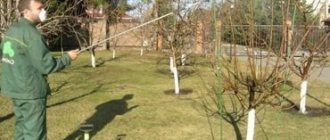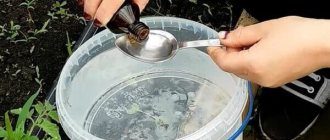Growing gladioli is a fun and rewarding activity. A wide variety of varieties attracts gardeners. Beautiful inflorescences of different shapes and colors can transform a site. But some gardeners, instead of luxurious plants, see small inflorescences and twisted stems in the flowerbed. The main reason lies in the fact that inexperienced lovers pay attention only to caring for flowers. And another important stage when growing a flower is often overlooked - the prevention and treatment of diseases or pest control.
Gladioli diseases
Onions, garlic, and gladioli suffer from all the same diseases as other bulbous plants. The greatest danger is caused by fungi that attack the bulb and leaves. In addition, pests pose a danger: aphids, caterpillars and mites (Figure 1).
Note: Most often, rare breeding varieties get sick, since their immunity is not strong enough to fight diseases on their own.
Figure 1. Manifestations of diseases on flowers
Every gardener strives to find a way to treat diseases of bulbs. However, when planting material is infected with viruses, it is almost impossible to fight them using both chemical and folk remedies, so the affected bulb is simply disposed of.
Causes
Having understood the causes and factors that led to the disease of the bulb, you can begin to treat the flower.
If you planted a new varietal bulb next to a diseased flower, then in the first year the crop will be protected from disease, but the very next year characteristic strokes and stripes may appear on the leaves of the plant, which indicate a viral infection. The bulb may be affected by gray rot or pests. This is due to the fact that the breeding varieties do not have sufficient immunity to independently fight diseases.
Symptoms
In addition to fungal, viral and bacterial diseases, gladioli are also susceptible to physiological diseases that are non-infectious in nature.
Among the infectious diseases that can affect all the flowers in a flower bed are (Figure 2):
- Fusarium - plants begin to turn yellow and dry out, starting from the lower leaves; the fungal pathogen penetrates the bulb from the soil and slows down the growth of the above-ground part of the plant. Affected bulbs become covered with brown spots. For prevention, they spray with Bordeaux mixture, and also strictly observe crop rotation, planting these plants in new areas every 2-4 years.
- Sclerotinia appears on acidic soils fertilized with humus, or when grown in the shade. With this disease, the plant's leaves dry out and turn brown, the bulbs lose their scales, dry out and turn black. For preventive purposes, the soil is treated with Bordeaux mixture, and the soil is also limed. All plants and planting material that have been infected are destroyed.
- Botrytiosis develops in persistent damp and cool weather. The symptoms of this fungal disease are brown spots on the leaves and characteristic watery spotting of the bulb, spreading to the stem part. This leads to rotting of the plant and corm. For prevention, plants are sprayed with Bordeaux mixture or copper sulfate, and the bulbs are treated with Maxim and Fundazol before storing.
Figure 2. Symptoms of diseases: 1 - fusarium, 2 - sclerotiosis, 3 - botrytiosis
If the cultivation of gladioli was carried out with violations, signs of non-contagious diseases may appear on the flowers.
They do not pose a serious danger because they do not spread from one flower to another.
If plants receive too much fertilizer, leaves and flowers may show signs of scorching. Lack of boron and iron leads to cracking of leaves and causes chlorosis. To eliminate such symptoms, crops are fed with complex fertilizers in a safe dosage.
Treatment
By adhering to the rules and recommendations, you can ensure the annual flowering of gladioli.
Since treatment of viruses and fungi is often ineffective, affected plants are dug up and disposed of along with the bulbs.
To preserve the beauty and health of gladioli, you need to follow these rules:
- It is recommended to observe correct crop rotation, since these plants are not grown in one place for more than two years;
- In places where gladiolus used to grow, it is best to grow phytoncidal annuals (nasturtium, calendula) to prevent the spread of fungi;
- Gladiolus is not grown in unventilated areas;
- For preventative purposes, plantings are sprayed with garlic solution (5 g of chopped garlic per 5 liters of water);
- In the autumn, plants and soil are disinfected with a solution of potassium permanganate;
In autumn, all plant debris is removed, the soil is carefully dug up and covered with a layer of organic mulch (peat, straw or sawdust).
Diseases of gladioli and their treatment: video
You can find out more information about gladioli diseases and methods of treating them in the video. Its author will talk about the main diseases of flowers and effective methods of combating them.
Prevention of diseases and pests
Prevention is the best way to combat diseases and pests of gladioli, since it is mostly impossible to save damaged plants.
- Application of crop rotation rules. Every year they change the place where gladioli are planted. It is best to complement the plantings by planting marigolds, calendula, nasturtium and mustard.
- Do not thicken the plantings and place them in well-ventilated areas.
- Monitor diseased gladioli plants in a timely manner and quickly remove them from the site.
- In the initial stage of diseases, treat with fungicides (Skor or Topaz) so that neighboring flowers do not become infected.
- Use pine needles or sphagnum moss for mulching.
- Regularly treat gladioli with insecticides. If the number of pests is small, you can use Fitoverm.
- It is mandatory to treat corms when storing them and before planting them in open ground.
Fusarium: how to treat
The causative agent of fusarium is a fungus that penetrates the bulb through the soil. Provoking factors may be an excess of nitrogen and ammonia fertilizers, as well as increased temperature and soil moisture (Figure 3).
Note: Newly dug bulbs, as well as plants before flowering, are especially susceptible to fusarium.
The first signs of the disease can be seen on the dug up bulbs. They become covered with small watery spots, which gradually enlarge and darken. Later, the folds wrinkle and become covered with white and pink mycelium of the fungus.
Figure 3. Symptoms of Fusarium
After storage, the bulb will not have visible signs of disease, but when planted, it may not germinate or may produce weak seedlings. An infected flower has a bending stem, drooping leaves, and the formation of buds is usually delayed.
To combat fusarium, the following preventive and therapeutic methods are used::
- Plants can be grown again in the same area only after 2-4 years.
- After flowering is completed, the soil is mulched and drained.
- Ammonia and nitrogen fertilizers are applied only when necessary and in small dosages.
- The bulbs are dried after digging before storing.
Before planting, it is advisable to disinfect the corms with karbofos or by washing them in a solution of potassium permanganate.
Why do gladioli wither without blooming?
Anomalies with flowering occur in gladioli if care rules are not followed, especially if the flower is a varietal one. When planting, the age of the child is important, it should not exceed 3 years, it is determined by the size of the bottom. The larger the “hoof” of a gladiolus tuber, the older the flower and the weaker its flowering. The young bulb is round and does not have a flattened shape, unlike the old one. Most often it has only one sprout, which can be used to determine its early age.
Important! Plant an old tuber with a large number of sprouts vertically (on its side) - numerous children will appear from it. This way you can quickly propagate valuable varieties
In the 4th year, the quality of the flowers, their simultaneous blooming, and the saturation of the tone are guaranteed to decrease - the plant is not able to pull out the simultaneous blooming of all flowers, so some will not be able to open, they will not have enough nutrition from the old, weakened bulb. A low-quality tuber leads to the problem of withering of the peduncle, which will not be able to bloom. To avoid this, you just need to regularly update the planting material.
The structure of a gladiolus flower. The small size of the bulbs does not solve the difficulties with flowering; most often they simply will not produce it. Usually, new tubers bloom without difficulty only in the second year after planting. You should not plant weak corms with damage. Mechanical injuries can lead to rot, and damage that occurs during storage is a sign of emerging diseases. Throw away tubers damaged by scab and flowering without regret - only a healthy bulb blooms without problems.
Pathogenic organisms penetrate into the injured mother plant from the soil, which can lead to the complete death of the flower. It is better not to plant old specimens mixed with young ones - oppression of the young will begin. Sort through the corms; the queen cells of the first sort, i.e. the largest ones, will guarantee the quality of the flower arrow. If the sprouts emerging from them are numerous, break them off without regret, leaving the only one, the strongest.
Find out how to fertilize gladioli at different growth periods.
It happens that the planting bulbs are young, the arrow is high, the buds are formed, but with each new flower that blooms, the first and subsequent ones immediately fade, a possible reason is a variety that does not involve powerful inflorescences and is not able to open and hold their number, its average indicators will not exceed 4 -5 simultaneous openings, which is included in the characteristics. This is often characteristic of very early types of gladiolus; mid-late and late ones are more hardy and decorative.
The exception is “Arina”, which is capable of driving out a tall peduncle and holding up to 9 flowers at the same time at the beginning of summer. Gladioli with an average flowering period are characterized by an opening of 8-9, and for late ones, maintaining 10-15 inflorescences on a stem is not a problem. Keep in mind that species that bloom in August have a certain heat barrier. In northern areas, flowering characteristics will change and flowers will fade faster. A powerful spike of 25 buds in the advertising brochure for an early variety will turn into 3 full-fledged flowers with a dozen faded ones without creating special forcing conditions.
Even if you organize an ideal climate, it will bloom in 70 days, which is not enough for the plant to form a strong above-ground part with a strong stem. Therefore, the average number of flowers will not exceed 15 buds in the middle zone. The microclimate of a personal plot is not suitable for all newly purchased specimens. If, for example, you are buying collectible varieties imported from abroad, or from a collector from another part of the country, remember that not everyone will adapt to conditions different from their usual ones.
Microclimate is important and affects the same species differently, which in one place of the site will not bloom at all, while in another it feels great. Over time, experience will suggest highly decorative groups that bloom with full bloom and retain their characteristics in your garden
Feel free to discard those that do not take root with you. When choosing a place for planting, take into account certain requirements, without which there will be no flowers or they will lose their decorative effect, withering without blooming.
A sufficient amount of sun without shading, non-thickening for free access of air, changing the location every two years, aerating the soil with mandatory loosening of the stem after watering - these factors will determine and increase the number of simultaneously blooming flowers in the future. Regular application of water during hot weather, summer-autumn root feeding, and mulching will correct and prevent the common problem of an unsightly stem with wilted flowers.
Bacterial scab: treatment
The causative agent is a bacterium that is constantly present in the soil and is activated under certain conditions. Most often, plants planted in areas with high groundwater levels or on clay and peaty soils are infected (Figure 4).
The symptoms of bacterial scab are expressed as follows::
- Reddish-brown spots appear on the lower parts of the leaves, which turn into rot in wet weather.
- The resulting reddish or blackish spots on the scales lead to the appearance of reddish-brown, oval-shaped sores with raised edges and a varnished surface underneath them on the corms.
At the initial stages of infection, damaged areas of the onion can simply be cut out and sprinkled with crushed coal. However, such planting material will not have a marketable appearance, and it can only be used on your own site.
Figure 4. Signs of bacterial scab on the bulb and leaves
To prevent the spread of bacterial scab, you need to improve the soil conditions in the area: dig deep, apply fertilizer or drainage. Before planting, the corms are treated with hot water and a solution of copper sulfate.
Why are there no flower stalks?
Experienced gardeners identify several reasons that “slow down” the flowering of gladioli.
Bulb quality
By purchasing old and weak planting material, the gardener dooms himself to a sad picture: the flowers did not bloom on time
First of all, it is important to choose varieties and varieties that can adapt to the climatic conditions of your region. It is also worth considering that some varieties can rest for several years after the first flowering, accumulating strength
We are talking about Dutch gladioli. Another important point: when collecting material yourself, the gardener must follow all the rules for storing bulbs and not forget about careful selection. Otherwise, you should not expect gladioli to bloom.
Wrong choice of location
This plant is very fond of sunny color, but it is better to protect it from the dangerous midday sun. Maximum lighting should be present in the morning and evening hours. In the shade, gladioli are unlikely to bloom lushly or the buds will be small and lifeless. Medium and late varieties of gladioli especially need light. It is better to choose an area for planting that is open and bright. However, it is still worth protecting the fragile flower from strong gusts of wind.
Another reason why gladiolus does not shoot an arrow in the first year is the condition of the soil. Soil that does not allow fresh air to pass through has a detrimental effect on the development of the plant’s root system. As a result, the risk of gladiolus becoming infected with fungi or other infections increases. Sometimes the gladiolus does not give the shooter because it was planted too close to the living space. Another important point: gladioli do not grow in one place for more than 2 years.
Violation of landing technology
The reason for the lack of flower stalks on the plant lies in the incorrect planting process. Sometimes gardeners make a number of mistakes.
In most cases, this is due to the quality of the soil. Skewers prefer breathable, well-drained soil rich in important trace elements and minerals. Soil preparation begins in advance (in autumn). With the arrival of warmer weather, the soil is loosened again, weeds are removed, and the necessary fertilizers are applied. If the soil is not properly prepared, its poverty will lead to a lack of flower stalks. Excessive deepening of the bulbs also affects the flowering process. The neck and bud should remain on the surface of the earth. An excessively deep hole retards the development of the plant. In addition, it is undesirable to plant young and adult bulbs in the same area. The latter will simply crush the young animals. Also, do not plant gladioli in overly moist soil (for example, during the rainy season). There is a possibility that excess moisture will lead to the death of the bulbs
It is important for inexperienced gardeners to understand that planting bulbs in unheated soil will lead to their death. The soil temperature should not be below +10 degrees. Close seating is not allowed
The distance between copies should not be less than 20 cm.
Poor growing conditions
Gladioli are known for their unpretentiousness and do not require careful care. However, beginners often make common mistakes.
- First of all, we are talking about private watering. In the hot summer, swords naturally need plenty of soil moisture. However, it is extremely undesirable to allow water to stagnate, as the roots of the bulbs will begin to rot.
- Rare watering is also detrimental to a captivating flower. If the surface of the soil is covered with crust, then the soil needs to be moistened.
- As for pruning, 3 to 5 leaves should be left on one bush so that the bulbs receive all the necessary substances. Otherwise, the plant will bloom poorly next year.
- Another reason why gladioli do not shoot is the lack of feeding. If the gardener did not have time to apply fertilizer immediately after planting the plant, then you should not wait for beautiful flowers on the site.
- In addition, some continue to add nitrogen during flowering. This procedure is prohibited, as the buds may wither without opening.
Gladiolus disease: hard rot
Rot affects leaves and corms. Light brown spots with dark borders form on the leaves, on which black dots subsequently appear containing fungal spores (Figure 5).
In autumn, the disease develops on the corms in the form of small, watery and round reddish-brown spots. The spots enlarge, and their central part turns black and presses inward.
Note: This disease is nicknamed hard rot because the affected tissues mummify and harden.
The infection remains in the soil for up to 4 years. The fungus spreads from plant to plant by spores that are carried by insects, wind and rain. The disease is especially dangerous in damp, cool years on soils with low fertility.
To prevent the development of solid rot, the following preventive measures are carried out::
- Diseased corms are discarded and disposed of;
- Planting is carried out only in areas where bulbous plants have not been grown in the last few years;
- Corms must be dried at a temperature of 25-30⁰ C immediately after digging, followed by pickling of the corms freed from scales. To do this, use a solution of potassium permanganate (15-30 g per 10 liters of water);
- After mass flowering, spraying with 1% Bordeaux mixture is carried out.
Figure 5. Symptoms of solid rot
In the fall, the flower bed is dug up deeply and organic and mineral fertilizers are applied. It is also advisable to cover the bed with a layer of mulch.
Fungal diseases
Fungal diseases of gladioli are also called rot.
Among them, fusarium or dry rot is considered the most dangerous and most common.
This disease is caused by the fungus Fusarium oxysporum f.Gladioli. Among modern varieties, gladioli have not yet been bred that are resistant to this insidious disease.
The causes of the disease are considered:
- a combination of waterlogging of the soil and humid warm weather;
- excess nitrogen in the diet;
- planting gladioli on damp, heavy soils;
- strong plant density.
Attention! Corms require the greatest attention during the period immediately after digging for storage and after planting in the ground.
How to determine damage to fusarium?
Externally, the disease manifests itself first by bending and thinning of the leaves, and then by their yellowing and drying out. If you look at the corm, you will notice red-brown depressed spots on it - signs of disease.
The danger of fusarium lies in its widespread distribution. If the corms are weakly affected by the disease, this will not save neighboring healthy plants from infection. It is especially important to inspect the material before storing it in order to protect the remaining gladioli. At the first signs of fusarium blight, diseased corms are removed. If the disease is noticed in the plantings, they are dug up at the same time as the soil around the plant. You can prevent a fungal infection by:
- disinfection of corms in a solution of “Fundazol”;
- dusting the planting material with the same preparation before planting;
- alternating 15-minute heating (55° C) and cooling in cold water.
If infection cannot be avoided, then the soil must be treated with thiazone and sand (1:1). The mixture is applied during autumn or spring digging of the soil.
The next disease of gladioli known to many gardeners is sclerotinia or black dry rot.
Like the previous fungal infection, it has the same reasons for its rapid development. But on acidic and damp soils, damp, cold weather stimulates the spread of the disease. A sign of damage will be the appearance of small dark spots on the leaves. The leaves become weakened at the base, turn yellow, then dry out. There are no pronounced signs of the disease on the corm, but the disease appears during storage. Spots of a yellowish tint appear, which, when enlarged, change color to red-brown, then black. The corm itself becomes hard and rots.
Gladioli of early varieties are more resistant to black dry rot disease. Preventive measures and methods of combating the disease are identical to those described above. If the soil on the site is heavy, it will help:
- adding coarse sand for planting gladioli;
- reducing soil acidity and moisture using known methods;
- harvesting corms before the onset of bad weather.
Important! To prevent disease, do not apply fresh manure under gladioli.
Another serious disease that requires the attention of gardeners is gray mold or botrytis.
Caused by the fungus Botrytis gladiolorum. It can develop at any period in the life of gladioli and affects all organs of the flower.
The leaves are covered with small brown spots with a red border. They grow, changing the color of the leaves, which die. In damp weather, a fluffy coating is noticeable on the leaves. The stem breaks, then lies down, and the rot penetrates below. The corm dies. Fungal spores are carried by water and wind. Control measures do not differ from other fungal diseases, but you can add treatment of corms with a solution of baking soda before planting (50 g of powder per bucket of water).
Less common diseases are penicillium and solid rot, smut, curvularia.
Pest of gladioli: thrips
Thrips damage all varieties of gladiolus. Pests overwinter under the scales of corms in storage, and can actively reproduce if the room temperature exceeds +10 degrees. In the spring, the eggs laid by the female hatch into larvae that damage the leaves and bulbs (Figure 6).
Note: Over the summer, pests can breed several generations of young animals, so you need to constantly fight pests.
Figure 6. Signs of damage to bulbs by thrips
It is very easy to determine the presence of thrips on gladioli: silvery spots and dots appear on the leaves of damaged bushes. Having noticed such a sign, you need to immediately treat the flowers with insecticides and repeat spraying twice with an interval of 14 days to destroy new larvae.
Why do gladioli have red leaves and dry flowers?
Many gardeners have encountered the appearance of red spots on the leaves. Their development is favored by long periods of cold, rainy weather.
Important! Infection of plants often occurs when the conditions for keeping the seed are violated, so it is necessary to periodically inspect the corms for the presence of damage by harmful microorganisms and promptly remove them, and carry out preventive treatment of healthy specimens with fungicides.
This disease can be distinguished from others by the following features:
- at the base of the leaves, orange or brown spores accumulate in pustules, from which, after cracking, spores of a color reminiscent of rust fly out;
- yellow round or oval spots appear on the outer surface, gradually turning into stripes;
- in the absence of measures aimed at combating rust, it can cover the entire surface of the foliage, which first turns yellow, later turns black and crumbles;
- buds and inflorescences dry out.
If the listed symptoms are noticed on gladioli, we can confidently say that the flower is damaged by rust, caused by basidiomycetes, which provoke diseases of bulbous and corm plants.
Onion root mite
Mites can attack all bulbous plants, including gladioli. Insects live on plant debris and quickly spread across bulbs planted in spring (Figure 7).
Note: Mites penetrate the bulb through holes formed due to mechanical damage, so all planting material must be carefully inspected before planting.
Figure 7. Symptoms of onion root mite damage.
The pest spreads especially actively in hot, humid weather. During such periods, plants need to be inspected regularly. If you find a gladiolus with yellowing leaves, it is better to dig it up and burn it immediately, as it has most likely already been attacked by mites and may pose a danger to other crops.
For prevention, plants are sprayed with karbofos or special chemicals against ticks - acaricides.
Viral diseases of garden gladioli
Flowers can be affected by diseases:
- yellow mosaic of beans;
- cucumber mosaic;
- yellow asters;
- tobacco ring spot;
- ring spot of tomatoes.
The list speaks for itself, because these diseases also occur on other plants.
A common problem is yellow mosaic virus.
An alternation of painted and unpainted areas appears on the flowers, which gives the inflorescences a variegated appearance. The flowers themselves become small, and the inflorescences become elongated. The corms become lumpy or, conversely, become flat and have a bluish tint. Transmission of the disease virus is possible at the time of cutting, by corms or their children.
Cucumber mosaic also leads to streaking throughout the entire plant.
As a result of this disease, gladioli quickly wither and look depressed with deformed peduncles.
When affected by mosaics, the spots may take on the appearance of a closed ring, and the leaves begin to curl. The bulbs are getting smaller. The carriers of these diseases are pests of gladioli (aphids, thrips). To overcome mosaic, it is necessary to fight parasites. Additionally, strict compliance with agrotechnical requirements, removal of all diseased plants, and selection of healthy planting material is required. Complete victory over the disease cannot be achieved using chemical means, so disease prevention will be the main weapon in the fight against mosaic.
Jaundice of asters
It can lead to the appearance of green flowers, thin seedlings resembling cereals, and curling of the inflorescences.
How to bloom gladioli. How to cut gladioli
Have you already purchased gladioli bulbs? Yes, this flower will decorate the background of the flower garden, but in my opinion, bouquets of gladioli will decorate your home to a greater extent. This flower will stand in your vase for a week at home or at work, just remove faded flowers, trim the stem, change the water.
The main rule when cutting gladioli is to save as many leaves as possible so that a replacement bulb grows, and you can cut the flower when two or three flowers open (this is the case with Dutch ones). Modern Russian gladioli keep up to 10-12 flowers open at the same time, so you can wait until 4-5 huge flowers open on the root. Don’t forget to pinch off the top one or two bud cones; they will open better and last longer in the bouquet. In the water, one or two fade (wither), one or two open higher.
UralSZ described how to cut without damaging the leaves on page 9:
“Features of cutting gladioli.
Task: leave as many leaves as possible to grow the bulb, at least 5-8 leaves. You need a narrow knife, I had a scalpel. With your left hand, hold the entire plant so as not to inadvertently tear it out of the ground or injure it from the effort; with your right hand, pierce the stem directly through the leaves, having previously counted the required number of leaves for the bulb. Move the scalpel slightly in different directions so as to finally cut the trunk, and then with your right hand, without letting go of your left hand, begin to gently swing the cut trunk from side to side. And so on until the trunk is pulled out of the leaves. The direct benefit is that the injury is small and hidden in the leaves. Plus, a sufficient number of leaves are left with the bulb, otherwise it is often visible that they were cut off along with all the leaves near the ground, or they are not cut at all and the ears are left until they are dug up. What happens: we admired the flowers, but the bulb gave everything it could, saving nothing for itself for its beloved. Disorder! The fact that you need to cut the flowers of gladioli is for sure. But now about something else. There are cases when the flowers on the peduncle are arranged somehow “skewed” - this depends on the variety. Because we know that gladioli, according to the structure of the spike, can be double-rowed, alternate, etc. Let's say that you have a two-row ear, and there is such a flaw in it... And you see that it cannot be removed by itself and this flaw will be visible in the bouquet. It can be removed in advance; before such a bud dissolves, we very carefully begin to turn it inside out with our fingers, moving it so that it is positioned strictly in two rows. It's easy to do, you just don't have to rush or put in a lot of effort. Such an operation will not prevent the ear from blooming correctly. Flowers should be cut either early in the morning or late in the evening. Do not cut during rain.
Fusarium (dry rot)
The most serious and dangerous disease of gladioli. The disease appears during the growing season and storage. The tips of the leaves begin to turn yellow, then the yellowness spreads to the entire plant. Gladioli dry out and die prematurely. The first signs of the disease appear in the second half of June, when the plants are in the 2-4 leaf phase. In gladioli affected by fusarium, the roots weaken and the plants are easily pulled out of the soil. The corms show signs of dry rot, usually at the bottom. Often the surface of the affected corms is covered with a white-pink fungal coating. The fungus can also be hidden in the planting material, without external signs. When favorable conditions occur (soil temperature above 20°C), the fungus begins to develop intensively and causes yellowing of plants. The source of infection is corms, plants and soil, where the fungus persists for 4 - 5 years.











